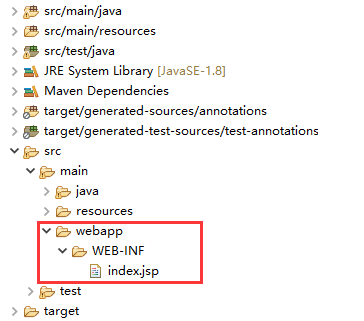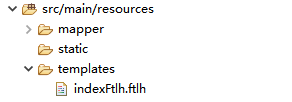SpringBoot第九集:整合JSP和模板引擎(2020最新最易懂)
当客户通过前端页面提交请求后,我们以前是怎么做的?后端接收请求数据,处理请求,把响应结果交给模板引擎JSP,最后将渲染后的JSP转为HTML,响应给客户端显示。JSP的好处就是当我们查出一些数据转发到JSP页面以后,我们可以用JSP轻松实现数据的显示,及交互等。JSP支持非常强大的功能,包括能写Java代码。
但是呢,我们现在的这种情况是,第一:SpringBoot这个项目首先是以jar的方式,不是war。第二:我们用的还是嵌入式的Tomcat(简化版的,即不支持JSP),所以呢,SpringBoot默认是不支持JSP的。如果我们直接用纯静态页面的方式,那给我们开发会带来非常大的麻烦,因此我们不得已选择,除了JSP外的其他模板引擎。
模板引擎的作用就是,我们来写一个页面模板, 比如有些值,是动态的,我们在通过写一些表达式,来动态的显示这些值,就像我们早前常用的JSP。模板引擎的作用其实都一样,只不过呢,不同模板引擎之间,他们可能这个语法有点不一样。Spring Boot支持FreeMarker、Groovy、Thymeleaf和Mustache四种模板解析引擎,官方推荐使用Thymeleaf。
对于模版引擎而言,SpringBoot默认存放模版文件的路径为src/main/resources/templates,当然也可以通过配置文件进行修改的。
当然了,使用JSP也是可以的,但官方已经不建议使用JSP了,本文也会讲解下SpringBoot下JSP的支持的,因为有很多老的项目还是使用JSP模板的居多。(不推荐使用JSP也是因为JSP需要编译转换,而其他模板引擎则无需编译转换)
1.SpringBoot整合Java Server Page
JSP(全称Java Server Page),是web开发最早期的模板引擎产品,随着时代的更新,已渐渐老去,当然目前还未完全退出市场。SpringBoot微服务架构,所有项目都是以jar文件方式打包部署,嵌入式的Tomcat(简化版,不支持JSP),所以SpringBoot默认是不支持JSP的,那么如果想要整合JSP,就需要独立引入整合依赖,和基础配置。
SpringBoot默认存放模版文件的路径为src/main/resources/templates,但由于SpringBoot默认是不支持JSP的,所以我们不能将JSP文件放在templates目录下。
- 引入JSP核心引擎
1 <!-- SpringBoot整合JSP:SpringBoot默认整合Tomcat,所以不需要指定JSP版本 --> 2 <dependency> 3 <groupId>org.apache.tomcat.embed</groupId> 4 <artifactId>tomcat-embed-jasper</artifactId> 5 </dependency> 6 <!-- JSP依赖JSTL --> 7 <dependency> 8 <groupId>javax.servlet</groupId> 9 <artifactId>jstl</artifactId> 10 </dependency>
- 创建JSP整合目录webapp以及WEB-INF
在Java,resources同级目录下新建webapp目录及子目录WEB-INF
至于web.xml配置文件,是可要可不要了。
- 修改yml文件,配置MVC试图解析器
1 spring: 2 # 配置整合JSP 3 mvc: 4 view: 5 # 配置视图解析器前缀 6 prefix: /WEB-INF/ 7 # 配置视图解析器后缀 8 suffix: .jsp
- 创建Controller跳转访问JSP
因为是返回页面 所以不能是@RestController// @RestController 该注解会将任何返回值都作为JSON暴露,不经过视图解析器 @Controller // SpringBoot整合JSP,不能使用@RestController public class PersonController { @RequestMapping({"/indexJSP","/listJSP"}) public String getIndexJSP() { System.out.println("JSP访问测试。。。。。"); return "index"; } }
- 启动SpringBoot主程序,访问测试
http://localhost:8080/indexJSP
1.说明:在完成上面的步骤之后,运行项目就可以访问jsp界面,但是别高兴的太早,当你打成一个jar包的时候,你会发现你不能访问jsp了,原因是SpringBoot打包时,是不会主动打包webapp目录的,你需要在你的pom文件手动配置把webapp的文件打包进去。详情参考附录。
2.常见错误:没有手动重启服务器!导致无法解析,错误代码500,显示信息:template might not exist or might not be accessible by any of the configured Template Resolvers(模板可能不存在,或者任何配置的模板解析程序都无法访问)
3.如果只是整合JSP,不整合使用其他模板,那么请不要引入其他模板依赖,也无需配置其他模板信息,否则会错错错!!!(SpringBoot默认支持的模板引擎,自然也有对应的默认配置,一旦你添加了对应的依赖,SpringBoot将遵循约定大于配置,自动注入,那你的JSP也就无法访问了)。
2.SpringBoot整合Freemarker
FreeMarker 是一款模板引擎: 即一种基于模板和要改变的数据, 并用来生成输出文本(HTML网页,电子邮件,配置文件,源代码等)的通用工具。 它不是面向最终用户的,而是一个Java类库,是一款程序员可以嵌入他们所开发产品的组件。官网参考
在Spring Boot中使用FreeMarker 只需在pom中加入FreeMarker 的starter即可。
- 修改pom文件引入FreeMarker 的starter
1 <!-- SpringBoot整合Freemarker --> 2 <dependency> 3 <groupId>org.springframework.boot</groupId> 4 <artifactId>spring-boot-starter-freemarker</artifactId> 5 </dependency>
- 修改yml文件配置FreeMarker
(可以不配,SpringBoot默认支持该模板)
1 spring: 2 # Freemarker配置详解(都含有默认配置) 3 freemarker: 4 # 模板加载路径(默认配置就是templates下,可以手动配置,多值使用“,”分割) 5 template-loader-path: 6 - classpath:/templates/ 7 # 配置缓存,开发阶段应该配置为false 因为经常会改,部署后建议开启 8 cache: false 9 # 配置编码设置 10 charset: UTF-8 11 # 建议模版是否存在 12 check-template-location: true 13 # Content-Type 值 14 content-type: text/html 15 # 模板后缀:默认为ftlh(这里测试更改为了html),如果你设置了模板后缀,那么新建的模板文件必须为指定后缀 16 # suffix: .html 17 # 是否启用Freemarker 18 enabled: true 19 # 详解配置可以查看FreeMarkerProperties类
配置说明:这里是向广大朋友概述/举例常见配置,并不是所有的都需要,SpringBoot含有默认配置,详情参考
org.springframework.boot.autoconfigure.freemarker.FreeMarkerProperties类,上面的配置中,实际仅配置关闭缓存即可。 - 新建FreeMarker模板
在src/main/resources/templates/下新建模板引擎。
FreeMarker模板默认后缀为ftlh,如果没有自定义配置,请遵循约定大于配置的初衷,新建模板且后缀设定为.ftlh。如果有自定义配置,则新建模板后缀为自定义的。例如:当前案例上面配置指定后缀为.html,那么新建的模板后缀就是.html,不必担心,会不会不支持FreeeMarker语法的问题。(模板引擎最终还是会转换为HTML的)
Feemarker语法:参考官网,参考中文网
1 <!DOCTYPE html> 2 <html> 3 <head> 4 <meta charset="UTF-8"> 5 <title>Insert title here</title> 6 </head> 7 <body> 8 Hello Freemarker!!! 9 <#-- FreeMarker注释:获取数值(注意:这里的${}是FreeMarker语法,类似于EL,要清楚这不是EL表达式,且这里的值不是null,否则会报错) --> 10 ${name } 11 </body> 12 </html>
- 编写Controller控制器,实现跳转访问
1 @Controller // 因为是返回页面 所以不能是@RestController 2 public class FreemarkerController { 3 4 @RequestMapping("/indexFtlh") 5 private String freemarkerShowIndex(String name, Model model) { 6 // 将接受的参数通过model共享(实际保存在request中) 7 model.addAttribute("name", name); 8 return "indexFtlh"; 9 } 10 }
- 启动主程序测试
访问:http://localhost:8080/indexFtlh?name=xsge
常见错误:没有手动重启服务器!导致无法解析,错误代码500,显示信息:template might not exist or might not be accessible by any of the configured Template Resolvers(模板可能不存在,或者任何配置的模板解析程序都无法访问)
3.SpringBoot整合Thymeleaf
Thymeleaf是一个XML/XHTML/HTML5模板引擎,可用于Web与非Web环境中的应用开发。Thymeleaf的主要目标在于提供一种可被浏览器正确显示的、格式良好的模板创建方式,因此也可以用作静态建模。在Spring Boot中使用Thymeleaf只需在pom中加入Thymeleaf的starter即可。
Thymeleaf官方网站,GitHup(Thymeleaf)
- 修改pom,引入Thymeleaf的starter依赖
默认的Thymeleaf版本为2.x.x.RELEASE版本,这里推荐使用3.0以上版本。建议在pom中将Thymeleaf的版本修改为3.0.x.RELEASE以上。(网上很多人说需要改,当然我没有改过,如果你想要更改高版本,可以参考——个人觉得没必要较真必须改,应当遵循你的项目情况而定,难道开发SpringBoot的人傻吗?)1 <!-- SpringBoot整合Thymeleaf --> 2 <dependency> 3 <groupId>org.springframework.boot</groupId> 4 <artifactId>spring-boot-starter-thymeleaf</artifactId> 5 </dependency>
1 <properties> 2 <thymeleaf.version>3.0.2.RELEASE</thymeleaf.version> 3 <thymeleaf-layout-dialect.version>2.0.4</thymeleaf-layout-dialect.version> 4 </properties>
- 修改yml文件配置基本信息
(可以不配,SpringBoot默认推荐该模板)
1 Spring: 2 #开启模板缓存(默认值:true) 3 thymeleaf: 4 cache: false 5 # 在呈现效果前检查模板是否存在. 6 check-template: true 7 # 检查模板位置是否正确(默认值:true) 8 check-template-location: true 9 # Content-Type的值(默认值:text/html) 10 servlet: 11 content-type: text/html 12 # 开启MVC Thymeleaf视图解析(默认值:true) 13 enabled: true 14 # 模板编码 15 encoding: UTF-8 16 # 要被排除在解析之外的视图名称列表 17 # excluded-view-names: 18 # 要运用于模板之上的模板模式。另见StandardTemplate-ModeHandlers(默认值:HTML5) 19 mode: HTML5 20 # 在构建URL时添加到视图名称前的前缀(模板加载路径:默认值:classpath:/templates/) 21 prefix: classpath:/templates/ 22 # 在构建URL时添加到视图名称后的后缀(默认值:.html) 23 suffix: .html 24 # Thymeleaf模板解析器在解析器链中的顺序。默认情况下,它排第一位。顺序从1开始,只有在定义了额外的TemplateResolver Bean时才需要设置这个属性。 25 # template-resolver-order: 26 # 可解析的视图名称列表 27 # view-names: 28 # -
- 新建模板
1 <!DOCTYPE html> 2 <html xmlns:th="http://www.thymeleaf.org"> 3 <head> 4 <meta charset="UTF-8"> 5 <title>Insert title here</title> 6 </head> 7 <body> 8 <div th:text="${url}"></div> 9 </body> 10 </html>
在html页面中引入thymeleaf命名空间,即,此时在html模板文件中动态的属性使用th:命名空间修饰 。(避免thymeleaf语法报错,标注警告等问题)
以下简单了解:详情请参阅博主模板语法笔记。th属性
html有的属性,Thymeleaf基本都有,而常用的属性大概有七八个。其中th属性执行的优先级从1~8,数字越低优先级越高。
-
th:text :设置当前元素的文本内容,相同功能的还有th:utext,两者的区别在于前者不会转义html标签,后者会。优先级不高:order=7
-
th:value:设置当前元素的value值,类似修改指定属性的还有th:src,th:href。优先级不高:order=6
-
th:each:遍历循环元素,和th:text或th:value一起使用。注意该属性修饰的标签位置,详细往后看。优先级很高:order=2
-
th:if:条件判断,类似的还有th:unless,th:switch,th:case。优先级较高:order=3
-
th:insert:代码块引入,类似的还有th:replace,th:include,三者的区别较大,若使用不恰当会破坏html结构,常用于公共代码块提取的场景。优先级最高:order=1
-
th:fragment:定义代码块,方便被th:insert引用。优先级最低:order=8
-
th:object:声明变量,一般和*{}一起配合使用,达到偷懒的效果。优先级一般:order=4
-
th:attr:修改任意属性,实际开发中用的较少,因为有丰富的其他th属性帮忙,类似的还有th:attrappend,th:attrprepend。优先级一般:order=5
-
- 编写控制器
1 @Controller 2 public class HtmlController { 3 4 @RequestMapping("/indexHtml") 5 public String indexHtml(Model model) { 6 model.addAttribute("url","XSGE个人网站:http://www.xsge123.com"); 7 System.out.println("ceshi"); 8 return "indexHtml"; 9 } 10 }
- 测试访问
启动SpringBoot主程序,单开浏览器访问:http://localhost:8080/indexHtml
常见错误:没有手动重启服务器!导致无法解析,错误代码500,显示信息:template might not exist or might not be accessible by any of the configured Template Resolvers(模板可能不存在,或者任何配置的模板解析程序都无法访问)
附录
SpingBoot整合JSP,打包问题:两种总结
1.网上很多说法是,在pom.xml中配置打包地址(这种方法可行)实现如下:
A,修改pom文件,在插件中配置JSP资源路径。
B,修改SpringBoot打包插件版本为(1.4.2.RELEASE)
C,运行Mavne命令打包
1 <!-- SpringBoot打包插件 --> 2 <build> 3 <plugins> 4 <plugin> 5 <groupId>org.springframework.boot</groupId> 6 <artifactId>spring-boot-maven-plugin</artifactId> 7 <version>1.4.2.RELEASE</version> 8 </plugin> 9 </plugins> 10 11 <resources> 12 <resource> 13 <directory>src/main/java</directory> 14 <includes> 15 <include>**/**</include> 16 </includes> 17 </resource> 18 <resource> 19 <directory>src/main/resources</directory> 20 <includes> 21 <include>**/**</include> 22 </includes> 23 <filtering>false</filtering> 24 </resource> 25 <!-- 打包时将jsp文件拷贝到META-INF目录下--> 26 <resource> 27 <!-- 指定resources插件处理哪个目录下的资源文件 --> 28 <directory>src/main/webapp</directory> 29 <includes> 30 <include>**/**</include> 31 </includes> 32 <!--注意此次必须要放在此目录下才能被访问到--> 33 <targetPath>META-INF/resources</targetPath> 34 <filtering>false</filtering> 35 </resource> 36 </resources> 37 </build>
很多人可能都在网上看到过类似的配置,但几乎没有明确版本!然而,这种配置方式在SpringBoot版本升级后,官方便提出不推荐使用,在SpringBoot1.4.x版本之后,推荐整合JSP时打包为war包方式,SpringBoot项目整合内置Tomcat插件,所以我们打包的war文件,无需考虑安装服务器问题,就把它当作一个jar文件一样运行即可
Java -jar 文件名.jar/war
2.无需在pom中过多配置,修改打包方式为war即可。
A,修改打包方式为war
B,运行Maven命令打包
C,启动jar测试访问
<packaging>war</packaging>